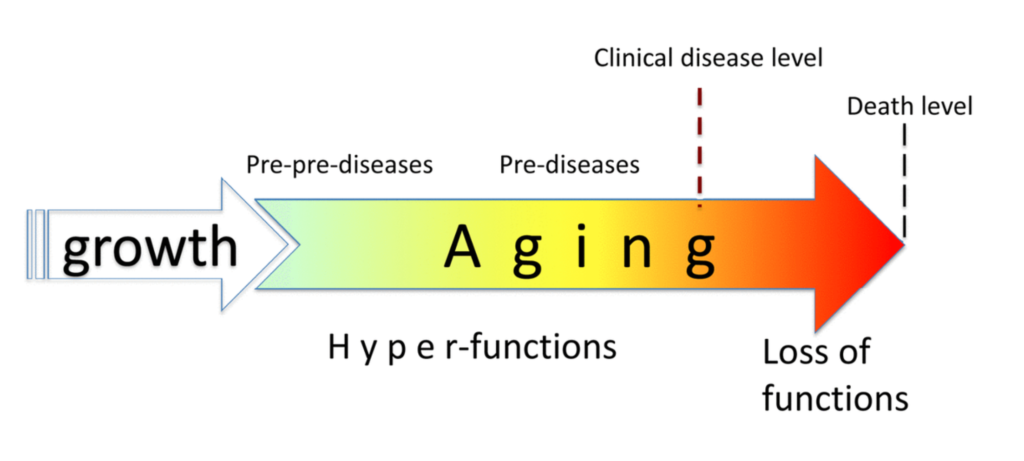Image: Figure 1. Relationship between aging and diseases. When growth is completed, growth-promoting pathways increase cellular and systemic functions and thus drive aging. This is a pre-pre-disease stage, slowly progressing to a pre-disease stage. Eventually, alterations reach clinical disease definition, associated with organ damage, loss of functions (functional decline), rapid deterioration and death.
The Top-Performer series highlights papers published by Aging that have generated a high Altmetric attention score. Altmetric scores, located at the top-left of trending Aging papers, provide an at-a-glance indication of the volume and type of online attention the research has received.
Read Aging’s Top 100 Altmetric papers.
—
Would officially re-classifying aging as a disease help fuel the anti-aging drug industry? While many sufficient arguments can place aging in this category, Dr. Mikhail Blagosklonny—Editor-in-Chief at Aging, Oncotarget, Oncoscience, and Cell Cycle, and adjunct faculty member at the Roswell Park Comprehensive Cancer Center—believes that classifying aging as a disease is unnecessary and counterproductive.
“It is commonly argued that aging should be defined as a disease so as to accelerate development of anti-aging therapies. This attitude is self-defeating because it allows us to postpone development of anti-aging therapies until aging is pronounced a disease by regulatory bodies, which will not happen soon.”
In 2018, Dr. Blagosklonny wrote a theory article that was published in Aging’s Volume 10, Issue 11, and entitled, “Disease or not, aging is easily treatable.” To date, this top-performing paper has generated an Altmetric Attention score of 54.
“Healthy” Aging
In this article, Dr. Blagosklonny emphasizes his theory that human aging is the quasi-programmed continuation of growth and development. He explains that, beginning after the growth process, progressive aging later in life results in aberrant systematic hyperfunction, which leads to disease and, eventually, death.
“Aging is a normal continuation of the normal developmental program, so it is NOT a program but a purposeless, unintended quasi-program [10–16].”
Dr. Blagosklonny segments the aging process into four stages: pre-pre-disease, pre-disease, clinical disease, and death (see Figure 1). In the early stages of aging, the unseen asymptomatic abnormalities which arise have not yet reached the currently agreed upon clinical definitions of disease. He explains that “healthy” aging can be interchangeable with “pre-pre-disease” and “pre-disease.”
“‘Healthy’ aging has been called subclinical aging [33], slow aging [18,34] or decelerated aging [35], during which diseases are at the pre-disease or even pre-pre-disease stage.”
Treating Aging
“Aging is easily treatable.”
Dr. Blagosklonny justifies this instinctually debatable claim simply by pointing out the ways in which humans are already defying aging. Calorie restriction, intermittent fasting, and the ketogenic diet have all been proven to slow aging and extend healthy lifespan. Certain nutrients, conventional drugs, and pharmacological therapies which have shown anti-aging properties include metformin, aspirin, statins, beta-blockers, ACE inhibitors, Angiotensin II receptor blockers (ARB), and (the anti-aging therapy Dr. Blagosklonny is most intrigued by) rapamycin, and other rapalogs.
“Rapamycin (Rapamune/Sirolimus), an allosteric inhibitor of mTOR complex 1 [63,66], is a natural rapalog as well as the most potent and best studied rapalog.”
Dr. Blagosklonny chronicles numerous studies over the years verifying rapamycin’s life- and health-extending effects in microorganisms, mice, humans, (non-human) primates, and even canines. Read more about the origin and applications of rapamycin.
Preventative Medicine is Anti-Aging
“Gerontologists think of metformin as an anti-aging drug [121–130], and metformin can be combined with rapamycin [131].”
In addition to the use of rapamycin and other anti-aging drugs, current preventative medicine strategies can be seen as anti-aging therapies, and vice versa. Dr. Blagosklonny discusses examples of preventative medicine and anti-aging therapy. In one example, patients who present with pre-diabetic symptoms may be treated with metformin to decrease insulin-resistance in advance, in order to prevent diabetes in the future. This is an example of preventative medicine as an anti-aging therapy.
“Physicians generally do not think of metformin as an anti-aging drug, simply because it is expected that life will be extended, if diseases are prevented.”
Conclusion
“Aging does not need to be defined as a disease to be treated.”
In conclusion, Dr. Blagosklonny proposes that “aging can be treated as a pre-disease to prevent its progression to diseases.” He suggests that, to preventatively combat disease brought on by aging, rapamycin and conventional life-extending drugs can be combined with “modestly low-calorie/carbohydrates diet, physical exercise, and stress avoidance.”
Click here to read the full theory article, published by Aging.
YOU MAY ALSO LIKE: More Aging Videos on LabTube
—
Aging is an open-access journal that publishes research papers monthly in all fields of aging research and other topics. These papers are available to read at no cost to readers on Aging-us.com. Open-access journals offer information that has the potential to benefit our societies from the inside out and may be shared with friends, neighbors, colleagues, and other researchers, far and wide.
For media inquiries, please contact [email protected].

